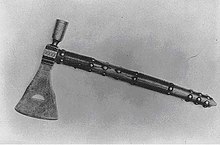tomahawk
The tomahawk is a weapon of various Indian tribes similar to the battle ax , but was carried almost as regularly as a tool and weapon by the whites as by the Indians.
description
Traditionally, the tomahawk has a short (25 to 50 cm long), straight, wooden shaft (mostly made of hickory ), similar to a hatchet . The head was originally made of stone or volcanic glass ( obsidian ), later it was also made of iron and occasionally brass , initially mainly for commercial purposes by the English and French.
Origin of name
The name Tomahawk was adopted into English in the 17th century from the Powhatan language ( tamahaac , "ax", "hatchet"), which belongs to the Algonquin languages and is now extinct . This is derived from the assumed original Algonquin * temah- "cut off with a tool". Word equations in other languages include Unami (South Delawarian ) təmahikan , Malecite-Passamaquoddy tomhikon and Abenaki demahigan .
Development history
Originally the tomahawk was a throwing club . The tomahawk later evolved into an all-purpose tool. Nevertheless, it is still often mistakenly viewed as a purely hand weapon for throwing. In addition to making kindling, it was also versatile in other ways: with a pipe bowl for smoking, with a hammer back as an important tool, with a spike as a weapon that is deadly on both sides. It was often used as a gift. Its symbolic effect was also important, depending on whether you showed the other person the (peace) pipe head or the ax blade.
Soldiers of the US Army wielded the tomahawk as a self-procured edged weapon, both in the Vietnam and in the Iraq war as a versatile tool and close combat weapon.
hatchet
On the one hand, the hatchet is used to denote the battle ax of the Indians, probably the tomahawk. On the other hand, the hatchet is to be understood as a symbol of war. The use of "dig up the hatchet" meant to start the war . “Burying the hatchet” accordingly meant ending the war .
Variants and similar Indian weapons
Various striking weapons such as the tomahawk were widespread among Indian tribes. In appearance and texture, however, these differed greatly from one another. A variant of the tomahawk is the rifle mace . The ball-headed club , an Indian striking weapon, is not considered a tomahawk variant due to the lack of an ax blade .
See also
literature
- Hans Dietschy : The American clubs and wooden swords in their relationship to the cultural history of the New World. Dissertation Phil.-Hist. Faculty of Basel. Brill, Leiden 1939, Chapter 11: The Tomahawk : pp. 118-122, Table 11 and Figure 11.
Individual evidence
- ^ Charles L. Cutler: Tracks that Speak: The Legacy of Native American Words in North American Culture . Houghton Mifflin Harcourt, Boston 2002, ISBN 0-618-06509-1 , p. 139 (accessed October 27, 2012).
- ↑ tëmahikàn . In: Lenape Talking Dictionary . Archived from the original on January 9, 2014. Retrieved October 27, 2012. - təmə- “cut off” and - hikan “tool”.
- ↑ Tomahawk ( Memento of the original from October 7, 2007 in the Internet Archive ) Info: The archive link was inserted automatically and has not yet been checked. Please check the original and archive link according to the instructions and then remove this notice. In: www.wissen.de , Wissen Media Verlag.
- ^ Report on ABC by David Tillet , (accessed December 9, 2009).
- ↑ Hatchet ( page no longer available , search in web archives ) Info: The link was automatically marked as defective. Please check the link according to the instructions and then remove this notice. In: www.wissen.de , Wissen Media Verlag.

